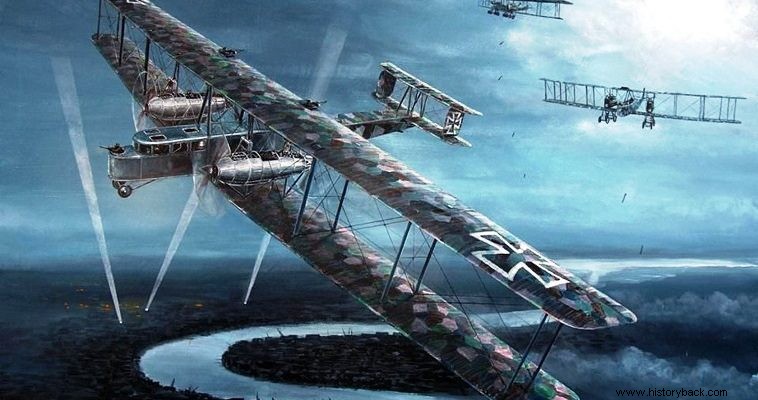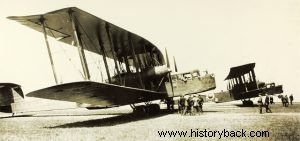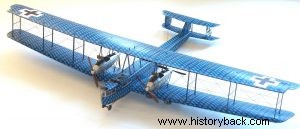
The Zeppelin Staaken R.VI was the most successful German heavy bomber of the First World War. Already at the end of 1914 the German command requested a bomber aircraft powerful enough and with a long range to be able to hit targets in Britain. Zeppelin, which specialized in airships, accepted the challenge and began designing heavy, for the time, bomber aircraft as well.
The famous Ferdinand von Zeppelin adopted the vision and in April 1915 the Versuchsbau Gotha-Ost (VGO) consortium's first creation, the VGO 1, was presented. The aircraft in question had three (later five) Maybach Zeppelin engines, had a wingspan of 42.2 m and was used in Eastern Front until its destruction. Three more VGO prototypes were later built. In 1916 the works were transferred to the premises of the Zeppelin Staaken Werke. It was there in the fall of 1916 that the Zeppelin-Staaken R.V, R.VI, and R.VII prototypes were presented.
Technical characteristics - performance
Finally R.VI. was chosen The aircraft was really huge and heavy by the standards of the biplane bomber era. It had a length of 22.1 m, a wingspan of 42.2 m, a height of 6.3 m and a crew of 7-10 men depending on the version. It was powered by four water-cooled six-cylinder Mercedes-D IVa engines with a power of 260 HP that gave it a maximum speed of 135 hp. or from four Maybach Mb.IV of 245 HP. It could carry internal bombs weighing up to 2,000 kg while its defensive armament consisted of 4 MG08/15 7.91 mm machine guns. The operational ceiling reached 4,350 m. It had a range of 800 km. Only 18 aircraft and one seaplane were built, which was destroyed in testing.
Operational action
The 18 bombers were joined by nine in two "giant bomber" squadrons, Riesenflugzeug-Abteilung 500 (Rfa 500) and 501 (Rfa 501). The first aircraft was delivered to 501 Squadron at the end of June 1917. Along with two other aircraft of the type the squadron received its baptism of fire on the Eastern Front carrying out night raids against Russian targets. In September 1917 the 501st Squadron relocated to Ghent, Belgium from where it would fly missions against British and French targets. The 500th Squadron was also deployed in Castine, in the then German-occupied part of France with the main mission of striking French airfields and strategic targets.
The Germans had bombed targets in Britain and especially in London mainly with airships. From May 1917, however, they launched Operation "Türkenkreuz" using bombers, causing a real panic in the British citizens. Gradually the British strengthened their anti-aircraft defenses and the Germans turned to night raids. German flying behemoths flew 52 missions against Britain dropping a total of 27,190 kg of bombs.
The first R.VI raid against Britain was carried out on the night of 28 September 1917. It involved just two R.VIs along with 25 other Gotha bombers. Due to bad weather most aircraft missed their targets. The two R.VI's successfully dropped their bombs. This was followed by isolated R.VI raids against London. Each such raid covered a distance of about 550 km and lasted about 7 hours. No R.VIs were lost in these raids to British air defenses but two crashed on return to base.
The aircraft were particularly robust, especially by the standards of the time. One even survived being hit by a British air defense balloon. Only two R.VIs were shot down by British fighters. Most were destroyed in accidents/accidents during night landings. One went down when fuel pipelines over the English Channel froze. Six aircraft survived the war. The R.VIs were the only German WWI bombers capable of carrying the beastly 1,000kg bombs.
The strategic effect of the German raids said by airships, or by heavy bombers was negligible. However, the raids, especially by aircraft that were extremely difficult to intercept, engaged significant British forces, "tying" them to British soil, which might otherwise have been deployed on the Western Front. Also the psychological impact of the raids was significant and certainly inversely proportional to their actual result.
The German aircraft could not be easily intercepted because when they arrived over British territory they were already flying at their maximum ceiling. It took quite some time for the British fighters of the time to reach the bombers' flying height and usually by the time they got high enough the German planes were on their way back. The chasers could hardly follow due to a small energy radius and the absence of any tracking mechanism.


